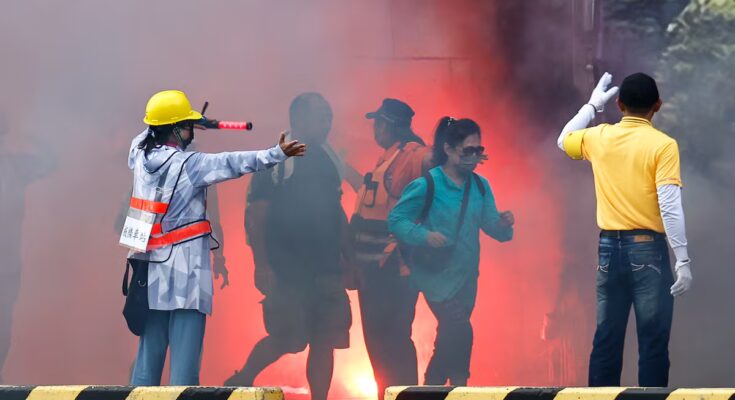This Wednesday, Taiwan began sending the latest update of its National Public Safety Guidance to inboxes across the island. It is the first time this booklet, with guidelines on how to respond to natural disasters or an attack by China, has been sent universally to Taiwan’s 9.83 million homes. The volume, whose publication began in 2022, contains this year, also in unpublished form, specific instructions on how to behave in the event that a civilian encounters enemy soldiers, and warns that, in the event of conflict, any information on the fall of the Taiwanese government is absolutely false.
The script starts with basic questions. “Do you have enough food, water and necessary supplies at home during a power outage?” “When communication breaks down, have you agreed on a meeting place with your family?” “Do you have a portable radio? Do you know the channel to listen to in case of emergency?” “Do you know that, in the event of an invasion, the Internet will be filled with disinformation spread by the enemy, aimed at undermining morale and destabilizing society?”
The guide was designed, according to the Taiwanese authorities, so that citizens are able to respond to possible threats, including natural disasters (earthquakes, cyclones) and also “China’s aggression”. Gives advice on how to prepare for kit emergency supplies (water, iodine, gauze, blankets, documents, some cash, whistle, radio, torch…) and how to position yourself in the event of an air attack when you haven’t had time to run for cover (“protect your head. protect your back in the direction of the explosion, stable and immobile, waiting for the opportunity to move…”).
“The ambitions of authoritarian states continue to increase on a global scale, threatening the international order through actions of military aggression,” reads one section. In these circumstances, he adds, “the peace and stability of the entire Indo-Pacific region are put at risk.”
The rubric includes the possible forms of threat, and can almost be read as an index of growing up in a possible war conflict with China. It starts with the destruction of critical infrastructure and submarine cables. It continues with the massive collapse of digital networks and the enemy country’s patrols around the island, asking to inspect Taiwanese ships. Maneuvering with live fire nearby. The unilateral imposition of maritime exclusion zones under the guise of military exercises. The appearance of enemy drones in the airspace. The unilateral suspension of trade and commercial activities between the two banks. And finally, the “launch of attacks, armed aggression or infiltration and sabotage actions by the enemy country”.
The waters of the Taiwan Strait are rarely calm. But this time the massive expedition coincides with a moment of particular tension. The self-ruled island, which China considers an inalienable part of its territory and to which the United States provides military aid, has been the punching bag of a serious diplomatic crisis between the People’s Republic and Japan for 12 days.
The dispute, which continues to affect relations between Beijing and Tokyo, originates from a comment by the Japanese Prime Minister, the ultranationalist Sanae Takaichi, who assured that an attempt by China to block or seize Taiwan could represent “an existential threat” to her country, which would justify the deployment of the Japanese Self-Defense Forces. The statement, which the head of the executive did not retract, seemed like a severe blow for Beijing: for China, Taiwan is a red line in its diplomacy.
Lin Fei-fan, deputy secretary general of Taiwan’s National Security Council and charged with overseeing the booklet, said in an appearance this week that the new manual aims to make one thing clear: “Under the threat of war, Taiwan will never surrender.” The new version, he added, takes as a reference similar documents circulating in northern Europe, including what is needed to prepare, reactive measures in different scenarios and what to do in times of war, as reported in the local press. During the September presentation, Lin said that Russia’s invasion of Ukraine made the publication of the guide urgent.
It also warns for the first time what to do if you discover “where the enemy is”. The pamphlet states that ordinary people may have difficulty clearly identifying troops of the invading force and warns that they may even masquerade as the Taiwanese army. Therefore, in the event of suspicious activity, it is recommended to leave the area quickly; If there is no time to escape, have someone hide and stay away from doors and windows. It also warns: “Avoid taking photos, recording videos and uploading information (on the Internet) about the movements of our troops, so as not to put them at risk.”
“In the event of a military invasion against Taiwan, any claim that the government would surrender or that the country would be defeated is false,” he also states categorically in a section dedicated to the “propaganda” of what he calls “hostile foreign forces,” without specifying that he is referring to China. “It could be used to divide us and weaken our resolve to protect ourselves.”
In another section you are asked to pay attention “to the cybersecurity risks” of applications of Chinese origin, such as DeepSeek, Wechat, TikTok and Xiaohongshu. And to some Chinese-brand devices with photography functions, such as surveillance cameras and image sensors. “In the event of a crisis, this equipment could also be used by the enemy,” he warns.



